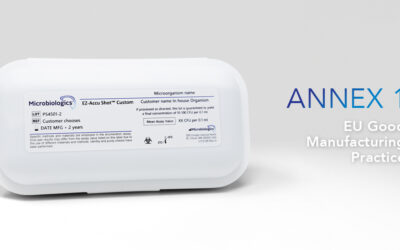As a pharmaceutical microbiologist, you are probably no stranger to Micrococcus luteus since it is among the most commonly found organisms in pharmaceutical environmental monitoring. The strain is typically associated with human skin, particularly from the head, arms and legs; consequently, inadequate aseptic techniques and gowning practices, and poor cleanroom management are frequent sources of M. luteus contamination.
Appearance:
Gram-stain positive, non-motile, non-spore-forming spherical cells. Cells occur in tetrads or irregular clusters.
Conditions for Growth:
Aerobic. Its optimal temperature range for growth is 25° to 37°C. It can grow at 45°C and in 10% Sodium Chloride. It will grow on a variety of media including Tryptic Soy Agar, Standard Methods Agar, Nutrient Agar, and Sheep Blood Agar.
Colony Morphology:
Colonies are circular, yellow, convex and smooth.
Habitat:
Found on the skin of humans and other mammals. It has also been isolated from foods such as milk, goat cheese and cassava fish.
Special Features:
Catalase positive. Lysostaphin resistant (Staphylococcus aureus is lysostaphin sensitive). Micrococcus luteus degrades the compounds in sweat into ones producing unpleasant odors. It also has the ability to degrade pollutants such as petrol.
Pathogenicity:
Although generally a harmless saprophyte, Micrococcus luteus can act as an opportunistic pathogen. It has been associated with a variety of illnesses including meningitis, septic arthritis, endocarditis, chronic cutaneous infections in HIV positive patients, and catheter infections.
Contamination Potential:
Micrococcus luteus is a common isolate found in pharmaceutical clean rooms during environmental monitoring. The likely source is humans. Its isolation in clean rooms can point to the need for better aseptic technique and gowning practices.
Family:
Micrococcaceae. Genus: Micrococcus. The family, Micrococcaceae, has been shrinking. Many members of the genus have been reclassified into other genera. For example, Micrococcus varians is now known as Kocuria varians. An interesting remaining family member, Microoccus antarcticus, was isolated from Antarctica, and is capable of growing at 4°C.
References:
Becker, K., von Eiff, C. (2011). Staphylococcus, Micrococcus, and Other Catalase-Positive Cocci. In Manual of Clinical Microbiology (10th ed., Vol. 1, pp. 692-713). Washington, DC: ASM Press.
Busse, H-J. (2012). Genus I. Ralstonnia. In Bergey’s Manual of Systematic Bacteriology (2nd ed., Vol. 5, pp. 571-577). New York: Springer.
Clontz, L. (2009). Microbial Life and Ecology. In Microbial Limit and Bioburden Tests: Validation Approaches and Global Requirements (2nd ed.). Boca Raton, Florida: CRC Press.
Jyothi K., et al. (2012). Identification and Isolation of Hydrocarbon Degrading Bacteria by Molecular Characterization. Helix Vol 2; 105-111.
Public Health Agency of Canada. (2011). Public Safety Data Sheet-Infectious Substances.
Personal Care Products Council. (2012). Cosmetic Microbiological Safety.






How do you treat a bacterial infection in a thumb joint that has been diagnosed as micrococcous luteus? Are antibiotics alone enough to rid the body of the bacteria?
It may be best to amputate the thumb immediately. Antimicrobial agents will be slow and ineffective. If the infection is spreading cut the entire hand off.
How and where can I get a pure isolates of micrococcus luteus for my experiment?
Hello! Microbiologics sells pure, authenticated microorganism strains in test-ready formats for laboratory quality control testing. Check out our website for a complete list of Micrococcus luteus products available. Orders for the United States can be placed on our website or via phone and email. Orders for outside the U.S. can be placed with one of our authorized distributors. You can locate a distributor on our website here: https://www.microbiologics.com/locate-a-distributor
What is the difference between Kocuria rhizophila and micrococcus luteus
??